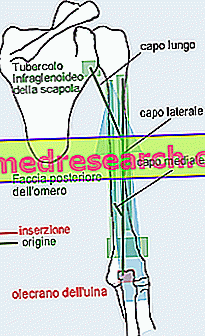
It consists of three muscular bellies (long head, lateral head and medial head) that originate in different points and end in a single tendon which is fixed on the olecranon of the ulna and on the posterior wall of the joint capsule of the elbow.
The long tail originates from the subglenoid tuberosity of the scapula; the lateral head originates from the posterior and lateral surface of the proximal half of the humeral diaphysis (inferiorly to the greater tubercle).
The medial head originates from the posterior aspect of the humerus, inferior to the radial nerve groove.
Its main action is to extend the forearm. The long head, unique among the three heads to act on two different joints (biarticolare), adduces (in synergy with the large dorsal muscle), extends and lowers the arm on the sagittal plane; it also participates in the retroversion of the scapula. The triceps is a classic example of a first type lever.

With the contribution of: Alessandro Stranieri
The point of action of the power (P) is on the olecranon of the ulna.
The resistance (R) represented by the weight of the load and forearm.
The fulcrum (f) of the lever is given by the articulation of the elbow
Since the arm of R is larger than the arm of P, the brachial triceps makes an increase in speed of action of the hand, with a reduction at the expense of force, but still remains at the level I (interfulcral).
The 1st kind lever is often represented with the fulcrum (f) equidistant from the resistance (R) and from the power (P). Often, however, in the levers of 1st genus the fulcrum, although always between P and R, may be more or less close to one of the two. If the fulcrum (f) is closer to the power (P) the 1st kind lever gains in "speed" whereas if the fulcrum (f) is closer to the resistance (R) the 1st kind lever gains in " power".
In the triceps, therefore, the 1st kind lever is of the fast type since the fulcrum (f) is very close to the Power (P) and very far from the resistance (R).
Obviously, everything is always seen from a static point of view, that is, as if it were the analysis of a still image taken from the various frames of a movie. In reality the dynamics of our body is definitely much more complicated and involves numerous additional interventions by the agonist, antagonist, fixer and synergist muscles and by the different joint frictions.
In the exercises of extension of the forearm with arms raised, as for example in the french press from sitting, the greater stretching to which the long head of the triceps is subjected implies a greater involvement of it compared to the other two muscular bellies.
On the contrary, when the arms are lowered, the stretching of the long head is minimal and the work is carried out mainly by the two mono-articular heads (medial head and lateral head).
Finally, when the arm forms a 90 ° angle with the scapula, such as in the French press on a flat bench, all three of the muscular bellies are stressed equally. This is the position in which the triceps develops its maximum extensor force. Also the position of the hand affects the involvement of the various muscular bellies in the movement. With supine hand the involvement of the lateral (external) head is greater, while with the prone hand the involvement of the medial head (internal) is higher.
It is innervated by the radial nerve (C6-C8)
ORIGIN Long head: from the subglenoid tuberosity of the scapula and the glenoid labrum Lateral head: from the posterior aspect of the humerus above and laterally to the groove of the radial nerve Medial head: from the posterior aspect of the humerus under the groove of the radial nerve |  |
| INSERTION With a common terminal tendon on the olecranon of the ulna and on the posterior wall of the joint capsule of the elbow | |
| ACTION Extends the forearm, adduces and extends the arm | |
| INNERVATION RADIAL NERVE (C6-C8) |
| Upper limb | Lower limb | Trunk | Abdomen | Articles |



